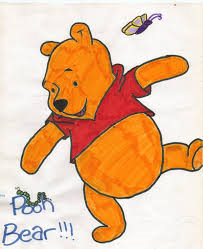
Pooh Bear and Friends
Perhaps no teddy bear is more beloved or well-known today than Winnie-the-Pooh. Born on October 14, 1926 (official publication date) through the pen of English author A.A. Milne, he was first known by his now famous name until December 24, 1925 when he appeared in a story by Milne, drawn by J. H. Dowd, published by the London Evening News. Pooh Bear, as he is sometimes called, is the star of books, cartoons, and animated feature films. He’s one of those bears that just gets better with age. And as a member of the Disney family, Pooh has actually passed Mickey Mouse as the most popular Disney character.
Milne created Winnie-the-Pooh for his young son Christopher Robin from a J. K. Farnell stuffed teddy bear belonging to Christopher named Edward Bear. The other characters, and their names, came from some of the stuffed animals in Christopher’s room: Tigger the tiger, Kanga the kangaroo, Kanga’s baby Roo (the toy Roo has since been lost), Eeyore the donkey and Piglet (Owl and Rabbit were created by Milne, while Disney added Gopher to the cast).
Sometimes Christopher Robin was a character in the stories; sometimes he was a child listening to his father tell the stories. Perhaps it was because he loved his stuffed toys so much that his father started making up stories about them, eventually writing them down. The resulting books were illustrated by E. H. Shepard, who used Christopher’s stuffed animals as models.
Pooh was a round little brown teddy bear. He lived in a small house in the Hundred Acre Wood, another name for the Ashford Forest in East Sussex, England, near where Milne had his country home at Cotchford Farm. The Hundred100 Acre Wood provided plenty of room for Pooh and his friends to play and have adventures.
Winnie-the-Pooh was named after a black bear at the London Zoo named Winnie and a black swan named Pooh. Winnie actually stood for Winnipeg, Manitoba, Canada, the bear’s owner’s adopted home. While a cub, Winnie had been bought by Canadian Lt. Harry Colebourn when Colebourn was on his way to England during World War I. The cub became the mascot for Colebourn’s regiment and was housed at the London Zoo when Colebourn and his unit were sent to France; Colebourn later donated the bear to the Zoo. Winnie became a popular attraction at the Zoo, where Milne often went with Christopher.
Winnie-the-Pooh became a popular figure with young and old alike, and his books were translated into many languages. Walt Disney also liked the books, so much so that he created full-length animated movies about Pooh, the first one in 1967. There would eventually be three Pooh movies, the last one released in February 2000 with Tigger as the main character.
Pooh was a lovable character even if he didn’t have much of a brain. That didn’t stop him from trying to think out solutions, even though, as Rabbit reminded him at least once (and in a kindly fashion), “you haven’t any brain” followed by Pooh’s humble response, “I know.”
Pooh loved to eat, and especially loved his honey (“hunny”). Pooh would do most anything for hunny, including eating the pot of hunny he was taking to Eeyore so that only the pot remained! It seems that he was also always ready to snack, even when polite manners might have prohibited him from asking for food when he was visiting friends. His primary snack of the day was scheduled for 11:00 in the morning, but as the clock in his house stopped at five minutes until eleven one day, snack time was anytime.
But change was in the winds. In January 1930 Stephen Slesinger purchased multiple merchandising rights for Winnie-the-Pooh from Milne, thus creating the modern licensing industry. Slesinger’s widow Shirley continued developing Pooh until she sold licensing rights to Walt Disney Productions in 1961. Milne’s widow Daphne also sold licensing rights to Disney that same year.
Disney has not only continued to develop Winnie the Pooh (minus the hyphens in Pooh’s name) and his friends as characters, but they have starred in his TV, animated films and featurettes. Disney has also created a huge business with Winnie the Pooh merchandising items. Disney was the one who added Pooh’s too-small bright red shirt; Shepard had illustrated Pooh without any clothing.
Winnie-the-Pooh has been so popular that recently other authors, including David Benedictus (October 2009), have written Pooh books. The Benedictus book was followed by a book by the British Beekeepers’ Association (June 2015) and a compilation of stories by four authors in 2016.
Thus Pooh lives on not only for children today, but also for parents who remember the Pooh of their childhood. Pooh had a gentle warmth, a big heart, and attempted to understand things even when he couldn’t. And what better place for a soft Pooh teddy bear than with a child rocking herself to sleep at night and dreaming dreams of sharing in Pooh’s adventures?
For you can’t help but love Pooh. He could be silly at times, and his adventures reflected that silliness, but his heart was always in the right place.
